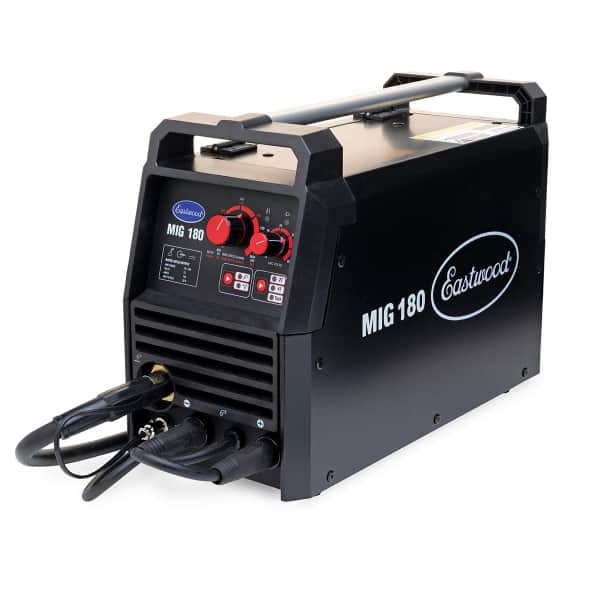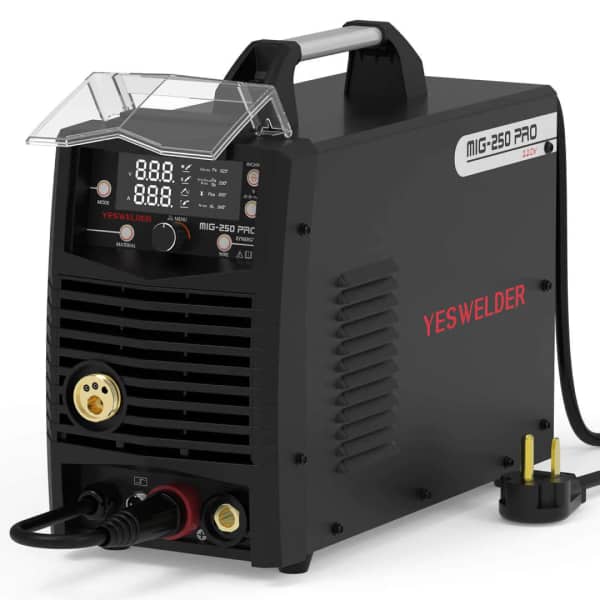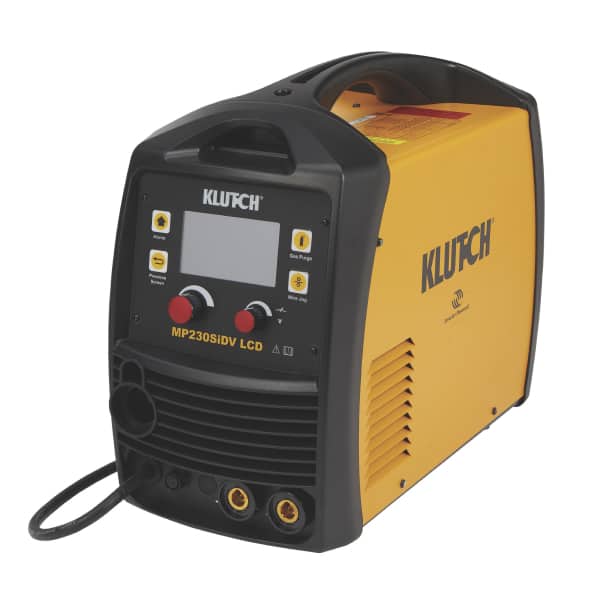Certain MIG welder features are more important than amps when welding auto-body parts.
Most MIG welders provide the needed power output and duty cycle.
But to maximize your auto-body welding experience, you need at least tack welding and 4T functions. Plus, spool gun support is necessary for MIG welding aluminum parts.
We selected the best MIG welders for auto-body work based on the supplied features, durability, and price range.
Most of these machines are suitable for automotive shops, but we also included inexpensive models for hobbyists and car enthusiasts.
A Quick Comparison
| Product | |||
|---|---|---|---|
| Image | Product | Details | |

|
Eastwood MIG 180 |
Spool gun support Tack/2T/4T Functions 3-Year warranty |
|

|
YesWelder MIG-250 PRO |
Feature-rich Spool gun support 220V Input power |
|

|
Klutch MP230SiDV |
Feature-rich 110/220V input 3-Year warranty |
|

|
Everlast Power MIG 253DPi |
Single/Double Pulse MIG 220V input 5-Year warranty |
|

|
Hobart Handler 210 MVP |
Transformer-core Made in the USA Dual-voltage input |
5 Best MIG Welders for Auto-Body
Here's the best 5 MIG welder for auto-body work:
1. Eastwood MIG 180 Auto-Body Welder

- Supports tack welding and 2T/4T modes
- Inverter-based for maximum mobility
- Spool gun support for aluminum
- 120/240V input
- 180A maximum output at 30% duty cycle
Pros
- Stable, crisp arc
- Great build quality
- Best price for a MIG welder and a spool gun combo
- Tack mode creates consistent spot welds
- Dual voltage input improves versatility
- Inverter-based and lightweight at just 26 lbs
- 4T feature for long welds
- Uses standard Tweco-style consumables
- Adequate duty cycle for most jobs
- Cast aluminum wire drive system
- 3-Year warranty
Cons
- No digital display
- Doesn’t include advanced features for arc control
- MIG torch lead is too short at 8.5 feet; professional shops have to upgrade the torch
Overview
You are unlikely to find a better combo deal for a spool gun and a quality MIG welder than the Eastwood MIG 180. While this machine misses a digital display and advanced functions like inductance control, it comes at an affordable price. Since Eastwood is a USA brand and covers its welders with a 3-year warranty, this welder provides the best value for most professional shops and car enthusiasts.
The Eastwood MIG 180 includes tack welding mode, which makes stitching body panels straightforward. Dial in your settings, then simply pull the trigger to make the same tack weld every time. The welder will not let you deposit more metal or achieve excess heat input by accident. Half of the car bodywork is tacking, and this mode makes that process effortless.
The included spool gun is more than capable of aluminum frame welding. The Eastwood MIG 180 can weld aluminum up to 1/4-inch thick, thicker than aluminum encountered in most body shops.
Besides some missing functions and a digital display, the Eastwood MIG 180 has a short MIG gun lead. The spool gun is a foot longer, so we can give it a pass. But, an 8.5 feet MIG torch lead is not enough for proper maneuverability around the car. So, if you are running a professional auto shop, you’ll need to make another investment for a lead replacement. The Eastwood MIG 180 can also be purchased without a spool gun.
2. YesWelder MIG-250 PRO Auto-Body MIG Welder

- 220V power input
- Supports MIG, FCAW, DC TIG, and stick welding processes
- Digital display
- Automatic settings
- Loaded with useful functions for arc control
- Spool gun support for welding aluminum
- 250A maximum output at 60% duty cycle
Pros
- Stable arc
- Decent build quality
- Intuitive controls with a digital display
- Long duty cycle and high amperage output
- It supports a spool gun
- Automatic and manual settings
- Includes numerous functions for arc control, which improves bead appearance
- Supports MIG/FCAW/TIG/MMA welding
- Cast aluminum wire drive system
- Inverter-based and lightweight
- 10-foot leads
- 1-Year warranty
Cons
- 220V input only
- TIG torch and spool gun sold separately
- The wire drive system is challenging to access because sheet metal partially covers it
- It doesn’t have a tack welding mode
- The shielding gas regulator is also sold separately. So if you don’t have one already, you can get it here
Overview
The YesWelder MIG-250 PRO is an inexpensive multi-process welder with many valuable features. For starters, you can TIG weld with it. That’s useful when making stainless steel welds on exhaust systems or intercooler piping. But, you need to purchase a TIG torch separately.
Speaking of additional costs, you also will have to buy the spool gun for MIG welding aluminum separately. Most cars nowadays have numerous aluminum body parts to reduce fuel consumption. So, if you work on cars, you’ll have to invest in a spool gun.
Rookie welders benefit significantly from the Synergic MIG (automatic settings) because it simplifies the setup process. Plus, YesWelder’s high-contrast digital display makes setup a breeze. But this welder also supports manual mode and fine adjustments of the auto settings if you need to tweak things.
The YesWelder MIG 250 PRO includes MIG inductance adjustability, allowing you to modify the bead profile. Most auto body welds need to be flush, and the adjustable inductance will help you achieve it, making your job easier by removing post-weld grinding.
We wouldn’t recommend the YesWelder MIG 250 PRO for high-end car shops because it only has a 1-year warranty. However, since this welder includes so many features at a relatively low cost, it’s a steal for beginners and car enthusiasts.
3. Klutch MP230SiDV Multi-Process Auto Body MIG Welder

- Supports MIG/FCAW/DC TIG/SMAW welding processes
- Large digital display with intuitive menu
- Inverter-based and lightweight
- Supports and includes spool gun and TIG foot control pedal
- It has numerous professional digital functions
- 2T/4T and tack welding
- Up to 200A output at 20% duty cycle
Pros
- Excellent arc stability
- Great build quality
- Inexpensive considering included features and accessories
- Dual voltage input
- Large, color display with intuitive menu
- It supports MIG, flux-cored, DC TIG, and stick welding
- Includes TIG foot pedal and spool gun
- 4T for long welds and spot mode for efficient sheet metal stitching
- Automatic and manual settings
- Includes wire run-in, inductance, pre and post-flow, arc force, hot start, and VRD settings
- 10-foot leads
- 3-Year warranty
Cons
- Low duty cycle
Overview
The Klutch MP230SiDV is more expensive than the already covered Eastwood and YesWelder offerings, but it’s far more professional. It’s a multi-process welder that also offers TIG foot control, which is incredibly helpful when welding visible seams on sports cars.
The MIG mode supports automatic and manual settings. You can modify your inductance to tailor the bead to the car body curve and fine-tune the wire run-in to reduce arc spatter when starting an arc. The MP230SiDV also comes with a tack weld mode for sheet metal stitching. So, when you hit the sweet spot of wire run-in to reduce spatter, the voltage of tack weld mode, and the inductance value, you’ll be able to make smooth, repetitive, flush to the body parts tack welds. That’s the power of having all these settings. It makes your job easier.
However, the Klutch MP230SiDV has one flaw — its duty cycle is short. This is not much of an issue for auto body welding, but keep this limitation in mind if you plan on welding something thicker.
Northern Tools provides a 3-year warranty, making the Klutch MP230SiDV an excellent deal for the price. It includes everything in the package; torches (MIG, TIG, and stick), a spool gun, and a TIG pedal.
4. Everlast Power MIG 253DPi Autobody Welder

- 220V power input
- Single and double MIG pulse for maximum weld quality
- Supports regular spool gun and push-pull systems for aluminum
- Synergic MIG and manual mode
- Includes a large number of digital functions
- Three LED displays
- Up to 250A output at 60% duty cycle
Pros
- Excellent arc quality
- Well-built
- Pulse and double pulse MIG offer welds with a similar appearance as TIG welding. Plus, pulse MIG is necessary for certain car shop welding standards (newer vehicles)
- Supports push-pull systems for professional aluminum welding
- Accepts up to 12-inch wire spools
- Automatic and manual settings
- 2T/4T and 4T special (more control)
- Inductance, burn back time, hot start, starting and ending amps, and pre/post flow settings
- Supports MIG/FCAW and stick welding
- 80V open circuit voltage
- Extra long duty cycle
- 5-Year warranty
Cons
- 220V input only
- Complex user interface
- Stick mode doesn’t support the E6010 electrode
- Doesn’t have a tack welding feature
- Spool gun is sold separately
Overview
If you run a professional auto body shop, you’ll probably need pulsed MIG to make the highest quality welds. It’s often necessary to MIG braze car panels when they are too thin to weld them. This is best achieved with pulsed MIG because GMAW-P offers lower average heat input and prevents distortion.
Additionally, double pulsed MIG welds are similar to TIG welds in appearance. Therefore, it’s possible to make the famous “stack of dimes” look. This is especially useful when working on car exhaust pipes or other visible stainless steel or aluminum elements. Some welders argue that GMAW-P is better than TIG welding, but we’ll leave that debate for another day. One thing is sure, though, pulsed MIG is faster and more productive than TIG.
The Everlast Power MIG 253DPi is one of the most affordable, professional-grade welders capable of MIG pulsing. It supports both push-pull and standard spool guns for welding aluminum. Plus, you’ll never push this machine to its limit in a car shop because its duty cycle is crazy long, so you can fully utilize the 4T mode.
Unfortunately, Everlast didn’t include a tack welding mode, which is a real shame. But, the Power MIG 253DPi comes loaded with other digital functions. For example, you can modify inductance, burn back time, wire run-in, hot start, starting and ending amps, pulse frequency, and other vital settings.
5. Hobart Handler 210 MVP

- Transformer-based for maximum longevity
- Dual-voltage input
- Spool gun support
- 7-preset voltage outputs
- Quick select drive roll speeds up wire changing
Pros
- Excellent arc stability
- Exceptional build quality
- Made in the USA
- 115/230V input
- Spool gun support
- Decent duty cycle for small shop welding
- Portable
- Industrial-grade angled cast aluminum wire drive system
- Hobart’s 5/3/1 warranty
Cons
- No digital display or advanced digital arc control functions
- Integrated ground clamp, but it doesn’t use standard DINSE plugs, making polarity switching complex
- Only 7-fixed voltage output settings
- Heavy at 79 lbs
- Low duty cycle for professional shops
- Expensive considering the lack of features
Overview
The Hobart Handler 210 MVP may be a good choice if you prefer transformer-based welders for longevity. It’s made in the USA, and Hobart provides a 5-year warranty on the transformer.
The Handler 210 MVP is characterized by Hobart’s well-known crisp, stable arc. But, since it lacks advanced features for arc control and doesn’t have a tack welding mode, you need more skill to make consistent tack welds when stitching auto body panels.
While this MIG welder was very popular (and still is), the Handler 210 is getting old. Newer welders we saw earlier in this review provide so many valuable features that the Handler 210 is overpriced by today’s standards. Still, Hobart makes an excellent transformer-based machine if you love simplicity. But, that does mean more work pre and post-welding.
For example, the Handler 210 doesn’t have infinite voltage adjustability. So, you can’t perfectly tailor the arc. Plus, you can’t accurately shape your welds or reduce spatter without inductance control or wire run-in. As a result, you’ll have to do more post-weld grinding.
MIG Welding Auto-Body Considerations
The more control you have over the heat input, arc behavior, and bead profile, the better.
Auto body welding is tricky because sheet metal quickly distorts or burns through.
Dealing With Tricky Metals
If you plan to work on cars, you’ll probably need to weld roll cages, frames, exhaust pipes, intercooler pipes, and other automotive parts besides sheet metal. These are often made from aluminum and stainless steel. So, having spool gun support is a bare minimum.
You should also consider some of the multi-process welders we discussed because DC TIG is irreplaceable for stainless steel.
Useful Features
As you are probably aware, welding auto-body parts primarily requires stitching sheet metal with tack welds. However, if these tacks are uneven, you can distort the material. So, if you don’t have the best MIG welding skills, consider a welder with an included tack mode.
Additionally, MIG inductance is helpful because it allows a small degree of bead height control, which can help reduce post-weld grinding. For example, if you are welding a seam joint on a rear quarter panel, the joint line may be along the curved portion.
So, if you tailor the bead height to match the quarter panel’s curve projection, you’ll need to do less grinding to smooth the weld before painting. But, be careful because inductance may increase spatter depending on the setting. So, it’s not a comprehensive solution.
You can also create a similar effect by modifying the voltage. But what if the needed voltage exceeds what’s acceptable for the panel’s thickness? This is the MIG welders challenge, and you can’t achieve everything by using basic voltage and wire speed settings. That’s why having more welder functions and settings is helpful.
Frequently Asked Questions
Is a MIG Welder Good For Auto Body Work?
MIG welders are great for auto body welding because they allow moderate heat input and fast travel speeds. They are versatile and easy to use.
What Size MIG Wire is Best For Auto Body Work?
The best MIG wire size for auto body welding is 0.023 in. diameter because it requires the least heat to melt. As a result, you are less likely to burn through the metal or warp it. But, sometimes, it’s necessary to switch to 0.030 in. wires. For example, welding thicker sheet metal or frame parts requires 0.030 in. wire.


